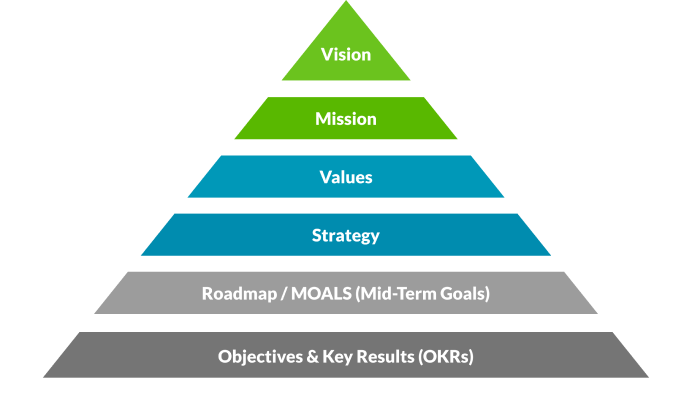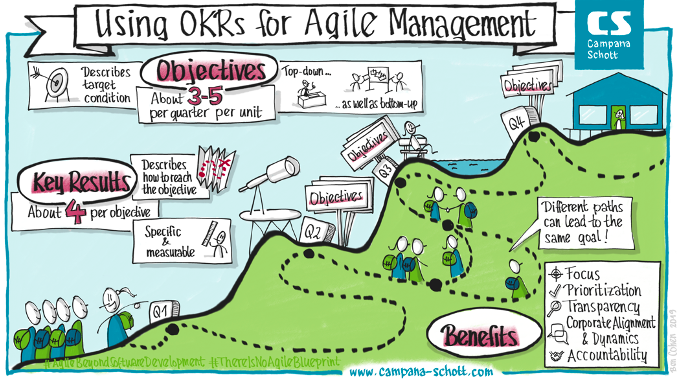Application scenarios of OKR in agile management
Carsten Frank has been working at the management and technology consultancy Campana & Schott as Expert Manager or Project Director since 2018. With over 20 years of experience in classic / agile Project Management and as a certified Project Director (IPMA A), he has worked in a wide range of industries as a Programme Manager and Head of Project Management.Today, his consulting focus lies on the development and establishment of PMO, program and portfolio structures, PMO management as well as agile and hybrid program and project consulting. He uses OKRs both internally and in customer projects. In 2019 he developed, among other things, an OKR-based program management approach for post-merger integration. Agile methods are especially known in the context of software development processes. But they also enable more flexible and adaptable approaches for organizations or organizational units. This is achieved, for example, by introducing "Objectives and Key Results" (OKR), which can be used in various application scenarios.Accuracy before speed: Especially in Germany, many long-established companies follow this motto. After all, the quality seal "Made in Germany" should still be valid today. But in the course of digital and sustainable transformation, such proven approaches are increasingly losing their validity. Not only do business models change or have to change, but very often also the organization of work in established organizations needs to change.Accordingly, companies today must streamline and accelerate their decision-making and change processes. To do so, they need agile and adaptive forms of organization that enable them to achieve even ambitious goals. The management tool of Objectives and Key Results is increasingly used for this purpose.
1. What are OKRs?
The OKR principle is based on the principle of breaking down the vision and goals of organizations into concrete, usable goals (Objectives) and formulating several usable and measurable results (Key Results). Objectives are often, but not necessarily, pyramidally aligned with the top level of the organization's Objectives (see Figure 1). Involving all levels of an organization is an explicit component of the approach.

Figure 1: OKRs are aligned with the top level of the corporate objectives
Similar to agile methods in Project Management, OKRs as a control instrument support the adaptation of short-term goals to current needs and ensure usable results in shorter intervals. Usually OKRs are thought in a timebox of 3 months.

Figure 2: Basic principle of OKRs
It also helps to compensate for deficiencies in the Balanced Scorecard and in simple "Management by Objectives" approaches. How exactly OKRs achieve this and what advantages they offer will be discussed in more detail below.
2. Use OKRs beyond the "classic" field of application
In practice, structuring management instruments such as OKRs are usually introduced afterwards. A pattern that can be found regularly, especially in the early phases of a company or after a merger, consists of the following four steps:
- A start-up or an organizational unit is founded by a (founding) team/supervisor and managed according to its own ideals.
- Rapid growth makes the size of the organization critical and requires the use of new, mature and comprehensive management tools.
- Steering instruments, such as OKRs, are introduced which have proven their worth in similar organizations.
- The value chain and culture of the organization are aligned to further growth and the necessary innovation through these or additional management instruments.
The unmistakable advantages of OKRs, such as
- Focus on key Objectives
- Transparency for all parties involved and thus the possibility of mutual assistance
- Short cycles in which the goal and desired results are reviewed
- Much better common orientation of the organization through discussion of path and goals
- The responsibility for desired, useful results can be easily assigned to teams and individuals
- So-called stretch goals help an organization to continuously challenge itself
These can also be transferred to existing structures and instruments in established companies with a little transfer performance. Like a turbocharger for companies in the direction of a future-proof organization.
Application scenario: target agreement
Target Agreement discussions and the associated variable salary components are a crucial fact in many companies. Sometimes the ideas for usable, value-adding results are missing in the annually repeated ritual (What can my contribution to the success of the company be?). Due to the usual one-on-one meetings intransparency and conflicting goals are virtually immanent in the procedure. And who has not found out in the course of the year that the agreed objectives are no longer relevant? This is a concrete opportunity for the use of OKRs.In order to use the target agreement as a real management tool, OKRs offer a simple and effective possibility. If annual targets are interpreted as mid-term goals (MOALS), interim targets and, in particular, Key Results can be broken down into quarters in the sense of immediately usable results. Targets and results can be proposed not only by the manager but also by the employee. For example, if the employee wants to be given time for innovations or projects, he or she must explain to his or her superior what he or she will deliver within three months. The question must be clarified how the agreement reached will contribute to the Vision, Mission/Purpose, Strategy or goals of the entire organization. Experience in implementing OKRs has shown how difficult it is for people to name useful results they want to achieve in a 3 month period. With a 12 month horizon, how are they going to do that? As a consequence, results are currently mostly left out of target agreements.However, this application scenario is often controversial among practitioners. A central argument of modern Performance Management is the necessity of decoupling Target Agreements and bonus payments. Here it is argued that central success drivers such as motivation and leadership, further development through feedback, as well as appreciation and recognition in performance management must be served in different formats and independently of each other. If in one and the same appraisal interview performance is evaluated, targets linked to bonuses are set and constructive feedback is given, these levels are mixed up in terms of content and targets are not set in the interests of the company or the customer for understandable reasons. In addition, in most cases, feedback on content cannot be accepted by the employee in such a setting, since the monetary relevant performance evaluation always resonates.One solution could be to offer a share in the company's success instead of individual bonuses. However, in many established European companies, direct participation, as is the case with young tech companies, is rather unlikely.
Application scenario: bracket around several project portfolios
Project, Program and Portfolio Management have also become standard in many organizations. It is the classic implementation tool of corporate strategies. The larger the organization and the higher the number of projects and portfolios, the greater the risk of losing clarity. In addition, conflicts of objectives arise between projects.OKRs can use Objectives at the corporate level to ensure a common focus on corporate goals. If entire projects or their milestones are reinterpreted in OKRs, a direct link between the worlds can be established here. In many cases, the formulation of project assignments and milestones is also improved. It becomes easier to understand WHY the project exists.A functioning OKR cycle in quarters also helps to synchronize projects and portfolios. Because instead of managing a multi-digit number of individual projects, OKRs one level above direct the focus on the really important and value-creating issues.
Application scenario: Operationalizing a new strategy
Another ritual in many organizations. Every X years a strategy process takes place. Developed at management level, announced over months and communicated with Big Bang. Nice and certainly important. But what did that mean for ongoing projects? How should the organization move in the direction of the new Vision and how do you determine whether you are actually moving in that direction?Without a tool like OKRs, individual employees often cannot see the impact for themselves and have no idea of their own contribution. In addition, even top management often lacks an idea of the necessary intermediate steps and the alignment between those involved.Once the Objectives have been specified in concrete terms and useful results (Key Results) have been agreed, the necessary discussion begins in the management team and between management and employees. As with the alignment of Project and Portfolio Management, the derivation of corporate objectives from the Vision/Mission, Purpose or Strategy is a key success factor here. Both the management team and the employees must be involved at an early stage.
Application scenario: Efficient post-merger integration
In the case of a merger, rapid and targeted post-merger integration is necessary in order to achieve the desired economic goals. In most cases the entire organization, or at least a large part of it, is affected. Many post-merger integration activities start before, with or after day 1/handover and run in parallel. There are great dependencies between the activities or sub-projects and the complexity is immense. Here, too, OKR-based program planning has proven its worth in order to give the companies involved a new direction as quickly as possible. If the necessary steps are broken down to the employees, advantages such as focusing, prioritization and improved communication support the new company on its way to becoming operational and capable of action again as quickly as possible. This is made possible by the high transparency of OKRs in the company.Before the merger, planning via roadmaps and mid-term goals (MOALS) can support the process. Here too, the concrete formulation of usable Key Results helps to cover the need for communication and expectation management. (Before Day 1, OKRs are usable planning states, after that OKRs control post-merger integration).

Figure 3: OKR-based program planning of a post-merger integration
Conclusion
These examples show: In addition to the classic areas of application of OKRs with a focus on growth, innovation and change in tech companies, established companies can also benefit from them. This includes in particular the areas
- Realignment of business models
- Linking of project and non-project worlds
- Coordination and focusing in organizations with a very large project portfolio
- Coordination of different project types
Using OKRs, these can be aligned with the company's objectives across the portfolio. The company benefits from better focus, prioritization and communication through the inherent transparency of OKRs (see Figure 2). In doing so, companies can use tried and tested methods and, through intelligent combination and consistent implementation, make their organization future-proof.

Figure 4: Benefits of Objectives and Key Results
This article illustrates how diverse and multidimensional OKRs are and how they can be applied in established corporates. Nevertheless, there are some pitfalls in the implementation of OKRs and teams need to answer the difficult question of how to integrate new processes into existing ones during the rollout.


-hero.webp)


